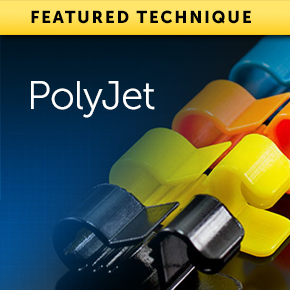The multi-material production capabilities of PolyJet industrial 3D printing have grown and developed over the last decade into one of more innovative rapid prototyping/additive manufacturing process in the field. Capable of incorporating as many as 46 colors and both rigid and flexible pieces into a single part or prototype, PolyJet industrial 3D printing allows service bureaus like ProtoCAM to create high-impact pieces quickly and cost-effectively.
 For industrial designers who need to create visually striking prototypes or short runs of multifaceted end-use parts, PolyJet rapid prototyping is often one of the best options.
For industrial designers who need to create visually striking prototypes or short runs of multifaceted end-use parts, PolyJet rapid prototyping is often one of the best options.
Presentation and Performance
When a project requires exceptional aesthetics, high tensile strength and the combination of multiple durometers in a single part, PolyJet industrial 3D printing is the answer. This particular additive manufacturing method is also well suited for parts requiring fine detail not easily captured using other techniques.
Using our Objet500 Connex3 PolyJet industrial 3D printer, ProtoCAM is capable of fabricating:
- Soft parts within stiff containers
- Overmolded products, such as a hard hammer with a rubber handle grip overlay
- Stunning, multi-colored parts and prototypes
In short, what used to take multiple machines and numerous production steps can now be completed at one time, on a single machine.
Specifications
PolyJet’s digital ABS has material properties nearly as tough as SLS or FDM, with aesthetics nearly as good as SLA, with the added advantage of color. ProtoCAM can mix hard and soft pieces within one product, in addition to fine tuning the photopolymer along a gradation of durometers, from soft to flexible to hard to rigid.
The most commonly used materials for the process include Objet’s Tango and Vero lines. These can be combined in a number of blends, with durometer/hardness values ranging from 27 to 95 Shore A.
PolyJet 3D printers can also create high-resolution results and small features in the Z dimension as the liquid photopolymer is laid down and UV cured in horizontal layers as fine as .0006 inch (16 microns). The process yields typical geometric accuracy of +/- 0.004 inches overall.
Typical Results
PolyJet industrial 3D printing is the ideal technique for the creation of multi-material, low-volume, production-ready parts and prototypes in a wide range of colors. In addition, PolyJet is often the fastest and most cost-effective option for composite parts, or those requiring ultra-fine detail and smooth finishes.
PolyJet 3D printing is …
- Quick: ProtoCAM typically fabricates PolyJet parts in three days, but, depending on size and material, can deliver some projects next-day or even same-day.
- Cost-effective: ProtoCAM prices PolyJet 3D printing competitively with other rapid prototyping techniques, including stereolithography
- Test-ready: Air- and water-tight, with good tensile strength for functional testing
- Detailed: Geometric accuracy and fine build layers
- Excellent for: High-quality and presentation-ready parts and prototypes
